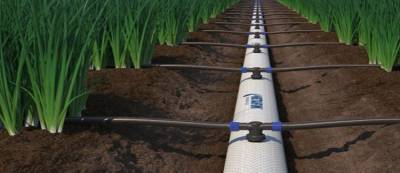NEW DELHI, 22 June 2022: Scented (Basmati) rice, a unique product of the Indo-Gangetic Plain, is known for its aromatic quality and high economic value. It generates about three times higher prices than coarse rice.
Approximately 20 percent of the land used to cultivate rice grows scented rice in India, and northwest states account for more than 90 percent of its total production. India contributes around 65 percent of the total global supply of scented rice.
The sustainability of the Basmati rice production in India has become a significant concern due to alarming water table depletion, growing food demand, stagnating, or declining productivity growth, and diminishing economic returns.
R Sabarinathan, Global Rice Agronomist at Netafim said, "Traditionally, rice is a water-intensive crop and requires water for three primary purposes – preparing land (puddling), continual seepage, percolation, and growing the produce. The farmer growing Basmati rice has to keep the area spread continually flooded, which results in substantial unproductive water losses (up to 80 percent) for reasons other than rice cultivation."
"The crop demands high water investments, labor, pre-crop preparation, and fertilizers. Despite these investments, farmers don't get the expected returns because water inefficiency resulting lower crop yield, and reduced crop quality affects their profits," Sabarinathan stressed.
Globally, India is one of the top basmati and non-basmati rice exporters. According to the statistics, in 2020-21, India's rice exports (Basmati and Non-Basmati) rose by a massive 87 percent to 17.72 million tonnes from 9.49 million tonnes achieved in 2019-20.
In terms of value realization, India's rice exports rose by 38 percent to $8815 million in 2020-21 from $6397 million reported in 2019-20. In terms of volume of Basmati rice exports in 2020-21, the top ten countries – Saudi Arabia, Iran, Iraq, Yemen, United Arab Emirates, United States of America, Kuwait, United Kingdom, Qatar, and Oman have a share of close to 80 percent in total shipments.
To achieve sustained growth in farmers' income and continue dominating the global export market for scented rice, ensuring scientific and egalitarian water application in agriculture and minimizing wastage of water is paramount.
The Indo-Gangetic plain (IGP) is an environmentally susceptible, communally momentous, and economically tactical sphere of India where landscape, groundwater, and soil fertility are threatened by climate change.
The expensive land preparation, wastage of water through flooding, and the inefficiency of conventional techniques add to rice growers' hurdles. Under these emerging scenarios, the farmers must focus on efficient alternative approaches for water use and start implementing drip irrigation for rice cultivation.
"Currently, the total area of rice under drip irrigation is around 500 Ha in India. Undoubtedly, it becomes imperative to introspect and overhaul agriculture practices in rice cultivation while acknowledging the efficiency that these upgrades would bring into the system", said Mr. R Sabarinathan, Global Rice Agronomist, Netafim said.
Drip irrigation reduces water use through a precise water supply to the crop. So, for the one kilo of rice that the farmers used to grow in 5000 liters of water conventionally, they now need only 1500-1600 liters. They achieve a higher crop yield on a large scale in lesser water.
Drip irrigation allows farmers to choose any desired close spacing crop after rice in crop rotation. They can also shift from low-income crops to high-income ones after cultivating rice. In paddy farming, rice roots remain submerged. They consume heavy metals and increase the arsenic in the harvest, thereby reducing the crop's market value. However, drip irrigation helps reduce the arsenic uptake by around 90 percent and further results in a high-quality and marketable crop growth.
The farmer community could reduce labor costs with drip irrigation, achieve water efficiency, increase crop yield, and improve crop quality. All of these factors reduce investments and increase profits. Additionally, Paddy cultivation produces around 10 percent of methane gas emissions globally. But, even if only 10 percent of paddy rice cultivators upgrade to drip irrigation, the world will be able to reduce methane emissions equivalent to those of a staggering 40 million cars. Controlled application of water and fertilizer has increased the productivity of the crops by 50 percent. All these boost farmer income levels by more than 40 percent.
The backbone of the success of drip irrigation in rice cultivation is awareness generation and practical training amongst small and marginal farmers in potential states. Studying the current drip-irrigation programs, Indian rice growers must adopt the technology at full scale with proper and accelerated execution. Continuing to tread the path of adopting suitable technology will make doubling farmers' income an achievable goal.























